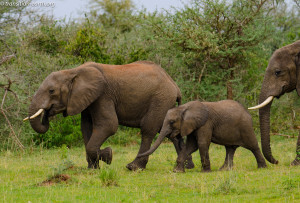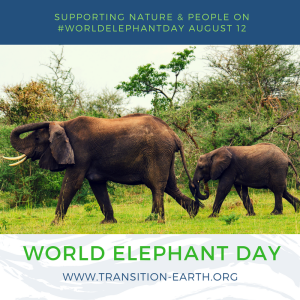What Does Family Planning Have To Do With Elephants?
Aug 11th, 2017 | By admin | Category: Family PlanningBy Suzanne York.
On this World Elephant Day, it’s well known to many people that elephants are on the path to extinction in the wild, if something isn’t done soon to change this narrative.Last year, the Great Elephant Census, based on aerial surveys, concluded there are just over 350,000 elephants in Africa. It is estimated there were several million of these majestic mammals at the turn of the 20th century. Some 27,000 are killed every year.
Elephants are dying off because of poaching and habitat loss/destruction (mainly due to urbanization and agriculture). National Geographic has an excellent map on the state of elephants in each of the 18 African countries surveyed by the Great Elephant Census.
Saving Elephants by Thinking Outside the Box
What if I told you there was a solution that could help save the world’s remaining wild elephants and improve the lives of people at the same time?
That solution is voluntary family planning. This is often considered “low-hanging fruit,” meaning it’s something relatively easy to address and not too costly in the scheme of things, as needs are being met today and not being pushed off into the future at unknown costs.
Recent statistics from the Guttmacher Institute help make the case for family planning:
- 214 million women of reproductive age in developing regions who want to avoid pregnancy are not using a modern contraceptive method.
- Of the estimated 206 million pregnancies in 2017 in developing regions, 43% are unintended (they occur too soon or are not wanted at all).
- The proportion of women who have an unmet need for modern contraception is highest in Sub-Saharan Africa (21%).
And the costs?:
- The estimated current annual cost of modern contraceptive services in developing regions, covering 671 million women who are currently using modern methods, is $6.3 billion, including direct and indirect costs. This is one dollar per person per year in developing regions.
- Expanding and improving services to meet all women’s needs for modern contraception in developing regions would cost $11.9 billion annually.
If you think that sounds like a lot of money, bear in mind that in 2016, Americans spent over $8 billion celebrating Halloween.
Uganda, Elephants and Reproductive Rights
What does this have to do with elephants? In Uganda, one of the countries where elephants are currently doing well, there are enormous pressures arising from a young and growing human population. While Uganda has many spectacular parks with elephants, this country – which is the size of the state of Oregon – has almost 40 million people, and could have as many as 100 million people by 2050.
With approximately 75% of the population under the age of 30, meeting their reproductive health needs is tied to the fate of elephants. Unintended pregnancies, high rates of teenage pregnancies, weak reproductive rights, weak women’s rights, and lack of access to contraception hurts people, and ultimately, animals too.
In addition to supporting and investing in reproductive rights for all, implementing a population, health and environment development approach can help change the dire outlook for elephants. This model empowers people and protects the environment by meeting human needs for contraception, reproductive health and general healthcare and linking it with conservation and management of the local environment. There are successful PHE examples in Uganda, Tanzania, and elsewhere in East Africa. See our factsheet on the PHE approach for more information, as well as this post on “The Connection Between Endangered Species and Family Planning” for how PHE is successfully working for people and mountain gorillas in southwestern Uganda.
Multiple Threats
Poaching is perhaps the biggest threat to elephants today. But even much of this comes down to meeting people’s needs and overcoming the negative effects of poverty and lack of education, jobs, healthcare and rights for women, amongst many other issues. Poaching is a huge issue and a topic for another day. In the meantime, check out WildAid for some success stories in changing cultural attitudes toward ivory consumption.
The threats to wild elephants are many, and almost completely driven by human needs and wants. If there are to be elephants and other wild animals in the future, different efforts to protect them will have to be undertaken. Voluntary family planning, especially when implemented through the PHE approach, can help people thrive, which in turn helps the elephants that live near and around them, too.
Suzanne York is Director of Transition Earth. She was recently in Uganda researching organizations implementing the Population, Health and Environment (PHE) approach.


![Young kids in the fishing village of Wanseko, in western Uganda [Photo: Suzanne York]](http://populationgrowth.org/wp-content/uploads/2017/08/Wanseko-kids-300x257.jpg)
